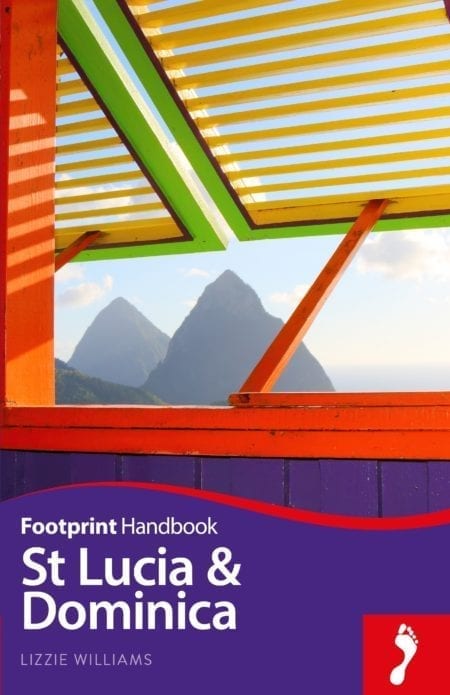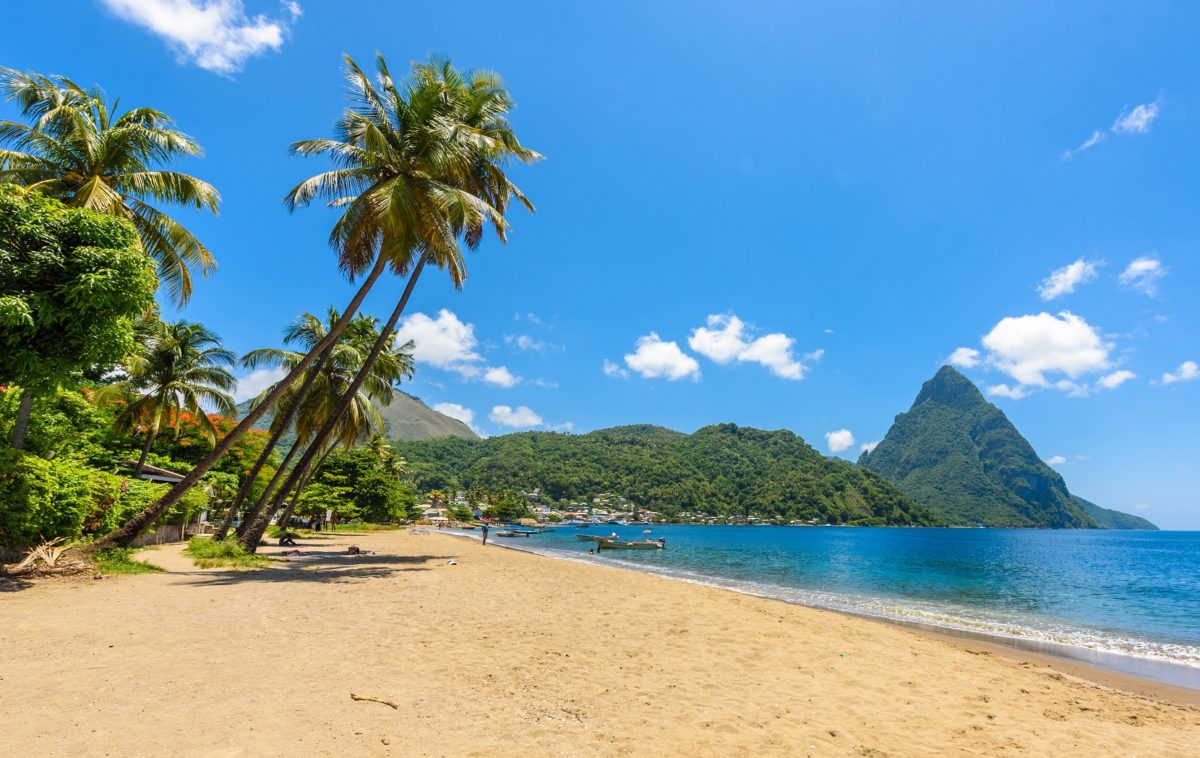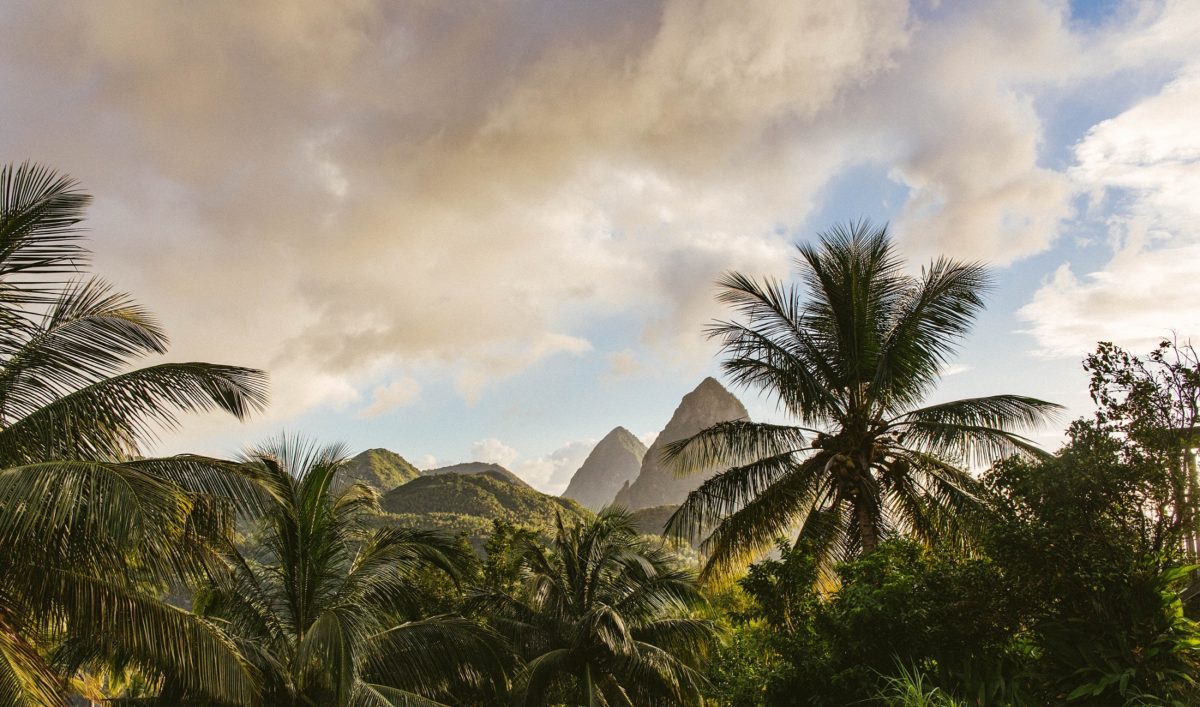Natural attractions abound on Saint Lucia with miles of rainforest trails to follow.
Lizzie Williams author of Saint Lucia and Dominica: The Bradt Guide
Saint Lucia: white sandy beaches, dense emerald rainforest and world-class resorts. But the island, measuring just 14 miles wide by 27 miles long, is much more than the sum of Caribbean clichés. Dramatic volcanic peaks like the twin Pitons, perched precariously on the west coast, rise sharply out of the ocean, and coves with gently sloping beaches alternate with small, brightly coloured fishing villages.
Saint Lucians are proud of their island’s history: from the mid-17th to mid-18th centuries, sovereignty of the island changed hands 14 times between the British and the French.
The British eventually won, but reminders of the French influence are evident in all aspects of life, particularly in place names: Soufrière, Marigot Bay, Vieux Fort. And Pigeon Island, connected to the mainland by a causeway since 1972, is a significant archaeological site, with ruins of a naval outpost, now protected by the St Lucia National Trust.
The vibrant blend of French, British, Carib and African cultures blend seamlessly into day-to-day life in the island’s larger towns of Castries and Rodney Bay, where there are opportunities for first-rate shopping and an award-winning choice of accommodation and restaurants suitable for all budgets.
Natural attractions abound on Saint Lucia with miles of rainforest trails to follow if you want to track down the endemic Saint Lucian parrot, the guinea pig-like agouti or the rarely seen whiptail lizard. Or if you prefer your wildlife wet, a range of water sports beckons: from guided snorkel trips and helmet diving, suitable for all ages, to advanced wreck diving on the Daini Koyomariu, a Japanese vessel teaming with angelfish, moray eels and parrot fish.
Whether you’re looking for a romantic honeymoon retreat, a lively trip to the Friday Night Jump Up street party at Gros Islet, or a safe swimming beach and pirate-themed adventures, Saint Lucia really is the destination for you.
Saint Lucia is on our list of 2023 Exceptional Trips! Read the full list here.
Food and drink in Saint Lucia
Food
Most hotels have restaurants on site and there’s a wide range of restaurants in major towns serving many different types of food. Local dishes include langouste (local lobster) cooked in a variety of ways, lambi (conch) and other fresh seafood, breadfruit and other local fruit and vegetables. Pepperpot and fried plantain are two local specialities worth trying. In general the food is a combination of Creole with West Indian and French influences.
Drink
Caribbean beer, including locally brewed Piton and Heineken is sold widely, and there are plenty of delicious fresh fruit juices also available. Local bottled water is available everywhere. Many imported spirits are available, however the local drink is rum (often served in punch and cocktails). Caribbean beer, including the locally brewed Piton and Heineken, and plenty of delicious fresh fruit juices are also available.
Health and safety in Saint Lucia
Health
Dengue fever is endemic in the Caribbean and can occur throughout the year. It is important to take precautions against mosquito bites. Use insect repellent and wear long-sleeved shirts and long trousers. Ensure routine vaccinations are up to date, and visit your doctor at least eight weeks before travelling to check if any vaccinations or other preventative measures are needed. Make sure that you have comprehensive travel insurance before you go.
Travel clinics and health information
A full list of current travel clinic websites worldwide is available on www.istm.org. For other journey preparation information, consult www.nathnac.org/ds/map_world.aspx (UK) or http://wwwnc.cdc.gov/travel/ (US). Information about various medications may be found on www.netdoctor.co.uk/travel. All advice found online should be used in conjunction with expert advice received prior to or during travel.
Safety
Use at least the normal precautions you would at home. Lock your door at night, avoid walking on deserted beaches after sunset, and keep your valuables and personal documents in a safe place. Take care at late-night street parties and only use licensed taxis.
Travel and visas in Saint Lucia
Visas
Passports must be valid for a minimum of six months from the date you leave Saint Lucia, but a tourist visa is not required by EU, US, Canadian, Australian or New Zealand citizens.
Getting there and away
By air
Virgin Atlantic flies three times weekly and British Airways five days a week between the United Kingdom and Saint Lucia from Gatwick; flight times are approximately 8 hours. From North America, American Airlines offers a direct service between Miami and Saint Lucia; American Eagle flies daily to and from Puerto Rico into tiny George Charles Airport, situated near Castries; US Airways once a week, direct to and from Philadelphia; Delta offers direct service from Atlanta three times weekly and Air Canada has a direct flight to Saint Lucia from Toronto twice weekly. Inter-island travel is well serviced by LIAT. Air Caraibes operates a daily flight to Martinique and Guadeloupe.
By sea
L’Express Des Iles runs a high-speed ferry service between Martinique and Saint Lucia. Cruise ships berth daily at Port Castries and Soufrière during cruise season. Major lines are represented in Saint Lucia by Cox and Company Ltd or Minvielle and Chastanet Ltd. For visitors arriving by private or chartered yacht, moorings are available at the fully serviced Rodney Bay Marina, and at the Moorings Marina in Marigot Bay, or at Soufrière.
Getting around
By road
There is a public bus system that operates from early morning to early evening, although outside of Castries and Vieux Fort services are less reliable. Taxis are available at the airports, resorts, shopping malls and at official taxi stands. Fares are fixed and drivers will tend to stick to these rates. There is a range of car rental companies on the island, to rent a car you must be over 25 and in possession of an international driver’s licence or temporary driving permit.
By sea
There are a few different ferry services which can be used to make your way around the island. There is a shuttle service which crosses the harbour in Castries, while in Rodney Bay there is a ferry which will take you between the marina, the village and Pigeon Island. Water taxis are common around Soufrière.
When to visit Saint Lucia
Saint Lucia can be visited any time of year, but may be more enjoyable during the dry, high season between December and April. However, even during the wet season showers are usually short, and the island will be quieter and cheaper than during the high season.
Climate
Saint Lucia’s climate is subtropical and humid, but is kept cool by the constant trade winds. Daytime temperatures range from around 27oC from November to February, to between 23oC and 29oC from April to October. December to February are the coolest months, while June to August is the hottest part of the year. The rainy season runs from June through to November, but showers are short and sporadic, and not a daily occurrence.
What to see and do in Saint Lucia
Castries
Founded in 1650, Castries, Saint Lucia’s capital, was devastated by fires three times between 1796 and 1948, meaning there are few buildings of historical value. It is, however, a bustling town full of St Lucian culture, with many sights worth seeing. Derek Walcott Square is the heart of the small city and is named after the St Lucian writer who won the Nobel Prize for Literature in 1992. At the eastern edge of the square is the Cathedral of the Immaculate Conception, while the Central Library can be found on the western corner of the square. Not far from here you can find Castries Market and the Vendor’s Arcade, both excellent spots for souvenir shopping. Castries Market is a dazzling display of local produce, arts and crafts, and is a great place to interact with local people. The Folk Research Centre has an interesting cultural archive and library, and puts on cultural events throughout the year.
Pigeon Island
A key landmark in Saint Lucia, the silhouette of the Pigeon Island’s twin hills can be seen from many of the beaches from Castries to Rodney Bay . Once used as a lookout point and military base when the British and the French fought over Saint Lucia during the 17th, 18th and 19th centuries, remnants of the military fort and bunkers used during that time can still be seen. Visitors can climb the lookout points at the top of the island for fantastic views over much of the volcanic interior of Saint Lucia, and across the Saint Lucia Channel to Martinique. Until 1972, when a causeway was constructed, Pigeon Island was an actual island, but these days it is actually connected to the mainland so you can get here by car, or for something different, take a water taxi.
The island is a popular venue for picnics and weddings due to its stunning views of the Caribbean Sea and Atlantic Oceanand is also home to the main stage performances of the annual Saint Lucia Jazz & Arts Festival held in May. There are two tranquil strips of sand on the protected, southern side of Pigeon Island where you can rent sunloungers and grab a bite to eat at the waterfront café. There are also watersports on offer near the café.
Plantations
There are several working cocoa plantations open to visitors on Saint Lucia. The Rabot Estate near Soufrière is owned by the upmarket British chocolate business, Hotel Chocolat. This is the island’s oldest estate, dating back to 1745. You can stay on the estate, and indulge in a range of chocolate-themed activities, including making your own chocolate or relaxing with a cocoa-based treatment in the Cocoa Juvenate Spa.
The estate’s restaurant, with its cocoa-inspired recipes, is also worth a try. There’s also the Fond Doux Estate, which offers a tour and lunch package, and La Dauphine Estate, where you can tour the plantation and sample some cocoa tea. Balenbouche Estate, a working plantation, is also worth a visit. If you’re staying at the exclusive Jade Mountain resort, guided tours of the private Emerald Estate are available.
The Pitons
The Pitons, twin towering inactive volcanic cones located near Soufrière on the southwest coast, are Saint Lucia’s most famous landmarks. These primeval peaks that rise steeply out of the ocean were granted UNSECO World Heritage site status in 2005. The more adventurous traveller can try climbing Gros Piton, which stands at 798m.
The first half of the trail is less challenging, winding around the mountain at a gradual slope and offering ocean views. The second half of the trail, however, involves the steep ascent of the Gros Piton summit, and the climb takes around four strenuous hours. The climb up the 749m Petit Piton requires specialist climbing equipment.
The road to Marigot Bay and Soufrière
Heading south from Castries, it’s a scenic drive through the Saint Lucian countryside to Marigot Bay and beyond. Although Marigot Bay is only less than 10km from Castries, the bay is much quieter, at least until night time when the north side’s bars and restaurants come alive. Leaving Marigot, the road runs through the Roseau banana fields and up into the hills.
The road descends to the village of Anse La Raye, worth a visit for the Friday Fish Fry, and then climbs again through the edges of the central rainforest, where if you’re lucky you may catch a glimpse of the endemic Saint Lucia parrot (Amazona versicolor). The road twists and turns around a series of hairpin bends to reach Soufrière, Saint Lucia’s oldest town. Originally the capital when the island was under French control, Soufrière is a great base from which to explore the surrounding sights, including the Pitons, Sulphur Springs, Diamond Botanical Gardens, Waterfall and Mineral Baths, and various estates and plantations.
Water sports
Saint Lucia’s clear, blue, warm sea is perfect for water sports. Scuba diving, snorkelling, windsurfing, kitesurfing, sailing and deep-sea fishing are all on offer. Scuba diving is offered at several reputable dive centres on the island and PADI and NAUI certification courses are available. For more experienced divers there are a variety of sites to explore, including wall dives, wreck dives and drift drives.
Some of the best diving is to be found within the island’s two marine reserves at Soufrière and Canaries. For non-divers there are excellent snorkelling opportunities, as well as the chance to try SNUBA, a combination of scuba diving and snorkelling, or helmet diving, an underwater walking tour suitable for all ages. Windsurfing and kitesurfing lessons are available at the Reef Kite and Surf Centre on Anse de Sable beach, and there is also equipment for hire.
Drive-in volcano
At Sulphur Springs near the historic town of Soufrière you can drive into the remnants of a dormant volcano, but don’t worry, the last recorded eruption was in 1766. The steaming pools and bubbling mud you can see lie on the weak spot of crust of the collapsed crater. You can learn more about the intriguing geology in an interpretation centre or by following one of the ranger-led guided tours, and then relax by bathing in the mineral-rich pools.
Rodney Bay
The Rodney Bay area is the island’s best known resort. The bay itself stretches from Pigeon Island in the north south for 5km towards Castries, lined with luxury hotels, a large marina but also the village of Gros Islet. The town of Rodney Bay, though, has a concentration of coffee houses, international restaurants, bars and nightclubs. The action is mainly situated on Réduit Bay Avenue, and the area is popular with visitors and St Lucians alike, particularly on weekends.
The area also boasts one of the island’s prettiest beaches in Réduit Beach, although this becomes busy in high season. Rodney Bay is also the best area on the island for some retail therapy, with Bay Walk Mall and JQ Mall within walking distance of each other. The Rodney Bay Marina is a popular spot for drinks and dining, and the marina is the end destination for the Atlantic Rally for Cruisers, a transatlantic sailing competition which starts off the coast of Africa in November.
Gros Islet is a small fishing village which is worth a visit if you want to escape the hustle and bustle of Rodney Bay. If you’re looking for a lively night out, however, the village hots up on Friday evenings when it hosts the Friday Night Jump Up. This street party is a great place to try authentic St Lucian food, and dance in the streets with the locals.
Go zip-lining
For an exhilarating experiences, you can zoom over the Morne Coubaril Estate near Soufrière. It’s one of the three places on the island where, safely harnessed to cables, you can whizz between platforms set high up in trees. Well-trained instructors guide you through the process. You don’t need to be desperately agile to take part – if you enjoyed a slide as a child, you’ll relish the experience. You can also go zip-lining near Babonneau with Rain Forest Adventures, who also offer gondola flights and hiking through the rainforest. Plus, there’s also Treetop Adventure Park near Dennery.
See the wildlife
There are plenty of opportunities for wildlife encounters in Saint Lucia, whether you’re trekking through the jungle, visiting beaches, or on or under the water. Saint Lucia’s rainforest is a habitat for many rare birds and plants, as well as the agouti, iguana and mongoose. The best way to experience the rainforest is with a well-informed guide, on one of the nature trails maintained by the Forestry Department.
For bird enthusiasts, there is the Millet Bird Sanctuary Trail. Over 30 species of birds can be found there, including five endemic species: the Saint Lucia parrot, Saint Lucia black finch, Saint Lucia oriole, Saint Lucia pewee and Saint Lucia warbler. This trail also provides breathtaking views of the Roseau Dam, the largest in the Eastern Caribbean. The beach at Grande Anse is a seasonal nesting site for endangered leatherback turtles, and from March to August you can join a patrol with the Desbarra Grande Anse Turtle Watch Programme.
If it’s marine life you’re interested in, there are a number of options for getting up close and personal. Whale- and dolphin-watching tours run all year long, and offer the opportunity to spot pilot whales, sperm whales, humpbacks and false orcas up close, as well as spinners, spotted, bottlenose and Fraser dolphins. If snorkelling or diving are your thing, then there are great sites to explore around the island with rainbow coral reefs and varied marine life. It’s possible to see octopus, turtles, moray eels, parrot fish and even sea horses.
Related books
For more information, see our guide to Saint Lucia:
Related articles
Here are our author’s picks for making the most of the island: Cricket Since the Beausejour Cricket Ground was built in 2002, St Lucia has hosted a number of Test and international matches, including the World Cup in 2007. The 15,000-seater stadium was renamed the Darren Sammy National Cricket Stadium in 2016, after St Lucian…
1. Castries Central Market Castries market is a hive of activity, especially when a cruise ship is in town. It’s a wonderful place to shop for tropical fruits and vegetables, as well as a staggering array of spices, including enormous chunks of cinnamon bark and shiny brown nutmegs, traditional coal pots and other souvenirs. 2.Rodney…


